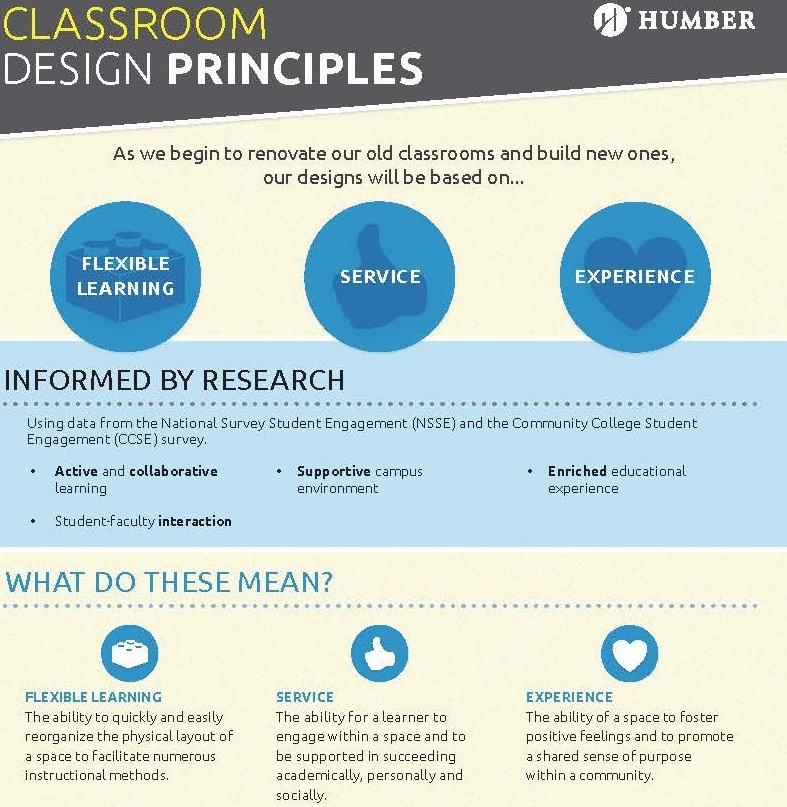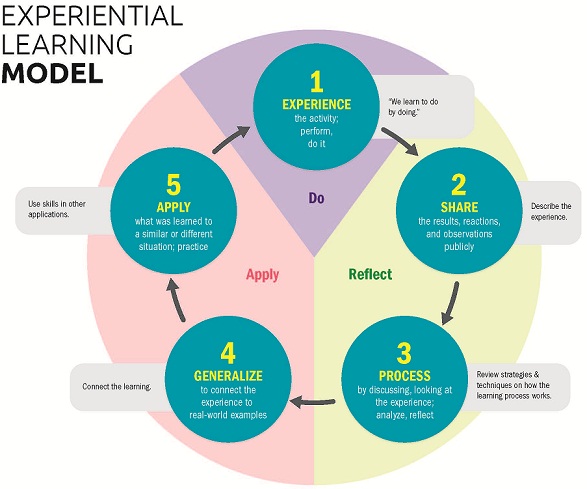
CRITICAL SUCCESS FACTORS
FLEXIBLE LEARNING
- Is consistent with current evidence-based and data-based practices
- Demonstrates ideologies and practices to support creative and maker spaces
- Is free of physical barriers; accessible to all learners (universal design)
- No fixed front or back of the room
- Is supported by technology as an enabler of learning – self-booking for faculty/students
- Includes tools to facilitate collaborative approaches to teaching and learning
- Incorporates opportunities to showcase and celebrate student achievements
- Provides mentoring, guidance, and support available to faculty on an ongoing basis
SERVICE
- Includes comfortable/adjustable furnishings
- Provides convenient storage options for materials, coats, bags, etc.
- Incorporates an abundance of power/charging options
- Features fast, reliable WiFi coverage
- Provides places for food and drink
- Employs current technology that effortlessly works at the speed of conversation
- Makes use of interchangeable components to minimize downtime
- Includes priority, on-demand support for technical issues
- Adheres to established safety standards
- Includes appropriately appointed layout for space and flow of movement
EXPERIENCE
- Supports a culture of reciprocity
- Accommodates any device a learner chooses to use
- Provides a warm and inviting atmosphere that is both clean and well maintained
- Offers a consistent and reliable teaching and learning experience with technology
- Harnesses as much natural light as possible, where practical and appropriate
- Includes fresh, clean air
- Ensures acoustics and sound-proofing are appropriately appointed
- Employs appropriate wiring and cable management practices
- Allows for the variable adjustment of artificial light
- Uses simple and intuitive technology controls
- Incorporates natural elements
Glossary of terms is available at www.humber.ca/classroomredesig

Passionate about progressing the climate of teaching and learning in higher education, Humber College is committed to enhancing the student experience through the Classroom Redesign Initiative. This re-imagining process is dedicated to student success and the goal of utilizing learning spaces to develop learning experiences that are engaging, enduring, and transformative.
A Classroom Redesign Committee has been assembled to map, plan and structure the project, and to ensure that the process and outcome will be fully integrated. Working together across the institution, the committee will act as a delivery vehicle to: re-negotiate and propagate the approaches in learning and collaboration, expand the breadth of flexible learning to allow for intellectual exploration through creative spaces, and inspire a culture of reciprocity where students and faculty learn with each other, as well as from one another.
Firmly embedded in this multi-phase initiative is a multi-year project aimed at remodeling classroom standards that better reflect the current atmosphere of teaching and learning philosophies, behaviours and practices. These standards will address the need for spaces that support autonomy in learning, and encourage hands-on, practical, and experiential learning.

Creating collaborative and active learning spaces will be a primary factor in stimulating learning and supporting student achievements. Guiding these principles and informing the decision making process for the project will be an amalgamation of data collected from the NSSE (National Survey of Student Engagement) and CCSSE (Community College Survey of Student Engagement), combined with current research literature. The Committee has completed a rigorous external review of best practices in learning spaces, as well as a thorough assessment of the current landscape of the classroom design across other institutions.
Moving from a one-size-fits-all solution, classroom spaces need to facilitate deep learning and be responsive to students’ needs. The ability to learn is cultivated from both inside and outside of the classroom. Learning spaces must reflect a ‘universal design’ model that supports andragogical (Adult Learning Principles) teaching and learning methods that incorporate maker spaces, flexible learning, and support the use of educational technology.
With a focus on enlivening the spirit of educational empowerment and maintaining a connection with community, the classroom redesign project will promote three essential design principles: focus on flexible learning, on service and on the learning experience. These fundamental principles were developed by the Humber community through a series of visioning and engagement consultations that included: roundtable sessions, focus groups (comprised of staff, faculty, students and administration) and online surveys. These principles will strengthen the design process during classroom renovations.
The initial phase of the classroom redesign initiative will focus on renovating two classrooms. Informing the redesign of K148 will be a strong focus on research, centered on student and faculty experiences. The redesign for the faculty training space, D236, will echo a diverse space built for discovery of new strategies for teaching and learning. This initial phase will inform and guide the design of future learning spaces and the redesign of the existing Humber classrooms.
Explore the project in depth, view our progress through images and find out more information about the Humber Classroom Redesign Initiative at: www.humber.ca/classroomredesign
Glossary of key terms and definitions can be found at: www.humber.ca/classroomredesign/content/glossary
Moving from a one-size-fits-all solution, classroom spaces need to facilitate deep learning and be responsive to students’ needs. The ability to learn is cultivated from both inside and outside of the classroom. Learning spaces must reflect a ‘universal design’ model that supports andragogical (Adult Learning Principles) teaching and learning methods that incorporate maker spaces, flexible learning, and support the use of educational technology.
With a focus on enlivening the spirit of educational empowerment and maintaining a connection with community, the classroom redesign project will promote three essential design principles: focus on flexible learning, on service and on the learning experience. These fundamental principles were developed by the Humber community through a series of visioning and engagement consultations that included: roundtable sessions, focus groups (comprised of staff, faculty, students and administration) and online surveys. These principles will strengthen the design process during classroom renovations.
The initial phase of the classroom redesign initiative will focus on renovating two classrooms. Informing the redesign of K148 will be a strong focus on research, centered on student and faculty experiences. The redesign for the faculty training space, D236, will echo a diverse space built for discovery of new strategies for teaching and learning. This initial phase will inform and guide the design of future learning spaces and the redesign of the existing Humber classrooms.
Explore the project in depth, view our progress through images and find out more information about the Humber Classroom Redesign Initiative at: www.humber.ca/classroomredesign
Glossary of key terms and definitions can be found at: www.humber.ca/classroomredesign/content/glossary
Click here to print the classroom redesign initiative key messages.
